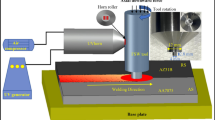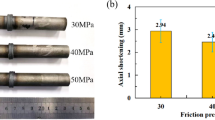Abstract
In this research work, friction stir welding of dissimilar AA7075-T651 and AA6061 aluminium alloys has been carried out by varying the material position and power of ultrasonic vibration (UV). Material flow, microstructure, hardness and tensile properties of the weld joint were mainly discussed . Results showed that the position of an AA7075-T651 material in the advancing side and ultrasonic power of 1.5 kW exhibited maximum tensile strength, hardness and bending strength. Elongation decreased with an increase in UV power. When using 1.5 kW UV power, the formation of multiple vortexes and distinct layers in the weld nugget zone improved the dissimilar joint property. A micro-void formation resulted from the lack of material filling and excessive turbulence when the UV power increased to 2 kW. The maximum compressive load of 50 kN was attained for the bending angle of 44° at 1.5 kW UV power. On increasing the ultrasonic power, dimples elongated and glided along the weld zone to cause void and tunnel formation .



















Similar content being viewed by others
Change history
18 October 2019
The Editor-in-Chief has retracted this article [1] because the eight cross-sectional macrographs shown in Table��3 are identical with cross-sectional macrographs that are part of Figure 1 in the article by Reza-E-Rabby et al. [2] which presents the results of a study using different tools and welding parameters. The data reported in this article are therefore unreliable. Darshan Rajesekaran and Yuvaraj Kunnathur Periyasamy do not agree with this retraction; Ashoka Varthanan Perumal has not replied to correspondence about this retraction.
18 October 2019
The Editor-in-Chief has retracted this article [1] because the eight cross-sectional macrographs shown in Table��3 are identical with cross-sectional macrographs that are part of Figure 1 in the article by Reza-E-Rabby et al. [2] which presents the results of a study using different tools and welding parameters. The data reported in this article are therefore unreliable. Darshan Rajesekaran and Yuvaraj Kunnathur Periyasamy do not agree with this retraction; Ashoka Varthanan Perumal has not replied to correspondence about this retraction.
References
Das U, Toppo V, Sahoo T K, and Sahoo R, Trans Indian Inst Metals 71 (2018) 823.
Heidarzadeh A, Barenji R V, Esmaily M, and Ilkhichi A R, Trans Indian Inst Metals 68 (2015) 757.
Amini S, Amiri M R, and Barani A, Int J Adv Manuf Techol 76 (2014) 255.
Shiraly M, Shamanian M, Toroghinejad M R, Jazani M A, and Sadreddini S, Trans Indian Inst Metals 70 (2017) 2205.
Ragu Nathan S, Balasubramanian V, Malarvizhi S, and Rao A G, Trans Indian Inst Metals 69 (2016) 1861.
Sevvel P, and Jaiganesh V, Trans Indian Inst Metals 68 (2015) 41.
Marzbanrad J, Akbari M, Asadi P, and Safaee S, Metall Mater Trans B 45 (2014) 1887.
Vijay S J, and Murugan N, Mater Des 31 (2010) 3585.
Liu Z, Yue Y, Zhang W, and Xing J, Trans Indian Inst Metals (2018). https://doi.org/10.1007/s12666-018-1360-6.
Khodaverdizadeh H, Heidarzadeh A, and Saeid T, Mater Des 45 (2013) 265.
Patel V V, Badheka V J, and Kumar A, Trans Indian Inst Metals 70 (2017) 1151.
Ilangovan M, Rajendra Boopathy S, and Balasubramanian V, Def Technol 11 (2015) 174.
Elangovan K, and Balasubramanian V, Mater Sci Eng A 459 (2007) 7.
Felix Xavier Muthu M, and Jayabalan V, Trans Nonferrous Metals Soc China (English Edition) 26 (2016) 984.
Ahmadnia M, Seidanloo A, Teimouri R, Rostamiyan Y, and Titrashi K G, Int J Adv Manuf Technol 78 (2015) 2009.
Liu X, Wu C, and Padhy G K, Scr Mater 102 (2015) 95.
Liu X C and Wu C S, Mater Des 90 (2016) 350.
Lv X, Wu C S, Yang C, and Padhy G K, J Mater Process Technol 254 (2018) 145.
Ma H K, He D Q, and Liu J S, Sci Technol Weld Join 20 (2015) 216.
Alinaghian I, Honarpisheh M, and Amini S, Int J Adv Manuf Technol 95 (2018) 2757.
Amini S, and Amiri M R, Int J Adv Manuf Technol 73 (2014) 127.
Ji S, Meng X, Liu Z, Huang R, and Li Z, Mater Lett 201 (2017) 173.
Ruilin L, Diqiu H, Luocheng L, Shaoyong Y, and Kunyu Y, Int J Adv Manuf Technol 73 (2014) 321.
Shi L, Wu C S, Liu X C, J Mater Process Technol 222 (2015) 91.
Zhong Y B, Wu C S, and Padhy G K, J Mater Process Technol 239 (2017) 273.
Sahu P K, Pal S, Pal S K, Jain R, J Mater Process Technol 235 (2016) 55.
Gao S, Wu C S, and Padhy G K, Sci Technol Weld Join (2018). https://doi.org/10.1080/13621718.2018.1476084.
Yuvaraj K P, Varthanan P A, and Rajendran C, Int J Comput Mater Sci Surf Eng 7 (2018) 130.
Li H, Zhang J, and Xiong Y, Sci Technol Weld Join 23 (2018) 308.
Shanmuga Sundaram N, and Murugan N, Mater Des 31 (2010) 4184.
Lakshminarayanan A K, Balasubramanian V, and Elangovan K, Int J Adv Manuf Technol 40 (2009) 286.
Babu S, Elangovan K, Balasubramanian V, and Balasubramanian M, Metals Mater Int 15 (2009) 321.
Aliha M R M, Shahheidari M, Bisadi M, Akbari M, and Hossain S, Int J Adv Manuf Technol 86 (2016) 2551.
Saravanan V, Rajakumar S, Banerjee N, and Amuthakkannan R, Int J Adv Manuf Technol 87 (2016) 2337.
Sabari S S, Malarvizhi S, and Balasubramanian V, Int J Mech Mater Eng 11 (2016) 5.
Hajihashemi M, Shamanian M, and Niroumand B, Sci Technol Weld Join 21 (2016) 493.
Sun T, Tremsin A S, Roy M J, Hofmann M, Prangnell P B, and Withers P J, Mater Sci Eng A 712 (2018) 531.
Zeng X H, Xue P, Wang D, Ni D R, Xiao B L, Wang K S, and Ma Z Y, Sci Technol Weld Join (2018). https://doi.org/10.1080/13621718.2018.1471844.
Kadlec M, Ru˚žek R, and Nováková L, Int J Fatigue 74 (2015) 7.
Reza-E-Rabby M, Tang W, and Reynolds A P, Sci Technol Weld Join 20 (2015) 425.
Golezani A S, Barenji R V, Heidarzadeh A, and Pouraliakbar H, Int J Adv Manuf Technol 81 (2015) 1155.
Giraud L, Robe H, Claudin C, Desrayaud C, Bocher P, and Feulvarch E, J Mater Process Technol 235 (2016) 220.
Daniolos N M, and Pantelis D I, Int J Adv Manuf Technol 88 (2017) 2497.
Liu Z, Meng X, Ji S, Li Z, and Wang L, J Manuf Process 31 (2018) 552.
Yang, J W, Cao B, He X C, and Luo H S, Sci Technol Weld Join 19 (2014) 500.
Author information
Authors and Affiliations
Corresponding author
Additional information
The Editor-in-Chief has retracted this article [1] because the eight cross-sectional macrographs shown in Table 3 are identical with cross-sectional macrographs that are part of Figure 1 in the article by Reza-E-Rabby et al. [2] which presents the results of a study using different tools and welding parameters. The data reported in this article are therefore unreliable. Darshan Rajesekaran and Yuvaraj Kunnathur Periyasamy do not agree with this retraction, Ashoka Varthanan Perumal has not replied to correspondence about this retraction.
[1] Kunnathur Periyasamy, Y., Perumal, A.V. and Rajasekaran, Effect of Material Position and Ultrasonic Vibration on Mechanical Behaviour and Microstructure of Friction Stir-Welded AA7075-T651 and AA6061 Dissimilar Joint,D. Trans Indian Inst Met (2018) 71: 2575. https://doi.org/10.1007/s12666-018-1389-6
[2] Md. Reza-E-Rabby, W. Tang and A. P. Reynolds (2015) Effect of tool pin features on process response variables during friction stir welding of dissimilar aluminum alloys, Science and Technology of Welding and Joining, 20:5, 425-432, DOI: 10.1179/1362171815Y.0000000036
About this article
Cite this article
Kunnathur Periyasamy, Y., Perumal, A.V. & Rajasekaran, D. RETRACTED ARTICLE: Effect of Material Position and Ultrasonic Vibration on Mechanical Behaviour and Microstructure of Friction Stir-Welded AA7075-T651 and AA6061 Dissimilar Joint. Trans Indian Inst Met 71, 2575–2591 (2018). https://doi.org/10.1007/s12666-018-1389-6
Received:
Accepted:
Published:
Issue Date:
DOI: https://doi.org/10.1007/s12666-018-1389-6




